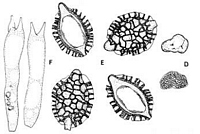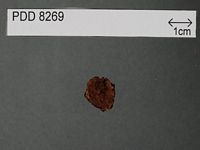|
 Hymenogaster macrosporus Hymenogaster macrosporus
BiostatusAbsent from region
Images (click to enlarge)
Caption: Hymenogaster macrosporus: D habit and section (Beaton 49) x 1;
E spores x 1750; F basidia x 1000. | 
Caption: Dried type specimen
Owner: Herb PDD |
Article: Beaton, G.W.; Pegler, D.N.; Young, T.W.K. (1985). Gasteroid Basidiomycota of Victoria State, Australia. 3. Cortinariales. Kew Bulletin 40(1): 167–204.
Description: Gasterocarp 6-20 mm diam., irregularly globose
to ovo-ellipsoid, with basal attachment. Peridium pale ochraceous to dull cream
colour or greyish, smooth and glabrous. Gleba dark ferruginous brown, loculate,
with small, irregular, empty chambers, 1-2 mm diam., without radial arrangement.
Tramal plates thin, 40-160 µm thick, white, consisting of a narrow hymenophoral
trama and well developed subhymenial layers; clamp-connexions present on all
hyphae. Columella none; steriles base minute, whitish.
Spores 17-24 x 9-12 (19.5 ± 2 x 11 ± 1) µm
(excl. orn.), Q = 1.77, limoniform with a protracted, obtusely rounded mucronate
apex, golden brown, thick-walled, bearing a strongly reticulate exosporial ornamentation
(-2 µm high), overlaid by a hyaline, disruptive myxosporium. Basidia 45-56 x
10.5 µm, cylindrico-subclavate, bearing two, straight sterigmata; also numerous
short ellipsoid, immature basidia. Hymenophoral trama regular, narrow, with
parallel, inflated, thin-walled hyphae, 2-25 µm wide, pseudoparenchymatous.
Peridiopellis a thin epicutis, 15-30 µm thick, of agglutinated, thin-walled,
hyaline hyphae, 2.5-6 µm diam.
Notes: A hypogeal species growing in small clusters,
either solitary or rarely confluent. The large, reticulately ornamented spores,
exceeding 20 µm in length, easily distinguish this species
|